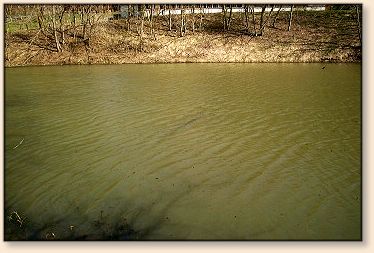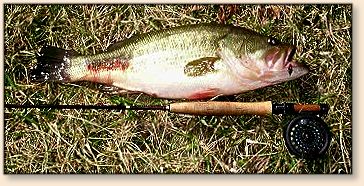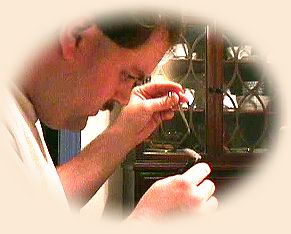The first weekend of spring, and we're finally out of
the below average cold of this year's winter. Last
weekend the daytime temps were getting in the 50's but
icy sheets still covered most of the small waters that
I frequent. Now, with a week of temperatures in the
high 50's to low 60's, I needed to get out fishing. At
work on Thursday I got the good news from a co-worker.
"Yeah, the sunnies are up in the shallows by the inlet creek.
The bass are even up chasing them!"
Good news indeed, at least it seemed so for the half day
that slipped by before the rain started. Lots of rain.
Overnight and into the next morning rain. Fear of the
Susquehanna cresting 21 feet at Harrisburg, which usually
runs at 6 or 7 feet in the winter. Thankfully, the worst
fears were not realized, but my lesser ones were. I got
to the pond to find it a chalky beige and full past the
usual banks. A cold breeze riffled the water up and
down the length of the pond. No full green trees on the
banks to shelter from the wind, only bare, stick figure,
mockeries of the growing season.

I hadn't cast my 4 wt in a good 6 months or more, so I
brought it with me, hoping to work it out against some
hungry spring bluegill. The wind was sharp in small guts,
but I rigged it up anyway, leaving the 6 wt in the truck.
What to fish? My usual MO is a small soft hackle, but
in this color of water a small, slim fly is not going to
get the attention it needs. Something small, but still
bulky and with some color. I had a variation on a McGinty
that I had received from a fly swap. The bright red tail,
a webby black soft hackle, this could work. I tied on the
fly and headed down to the water.
I tucked myself in under the large walnut tree and stripped
some line off the reel. I had spent the morning cleaning
and treating lines, cleaning reels, and all the other
maintenance to shake the winter off. A 20 foot cast
into the middle of the cove, and I fell in love with
this little 4wt rod all over again. It's the first
fly rod I've made, and that's probably a big part of
the infatuation. It helps that it casts like a dream,
even in my clumsy hands. My silent adoration is
interrupted by a sharp rap at the end of the line,
and then nothing.

A couple of casts later, the fly line jolts again, and
I set the hook. The line tightens to my hand and then
shoots up towards the deep water. Definitely not a 'gill.
A few minutes later a pale largemouth about 8" jumps free
of the shallow water near my feet. I quickly unhook it
and back into the water. In between empty retrieves and
the occasional short strike, I manage to land a couple of
small, silvery bluegill. Another cast sails out and I
let the fly settle towards the bottom. Short, slow strips
are the name of the game today, and this time the line
comes up solid and heavy. It glides in immediately under
pressure, and I can see the large branch coming up out of
the murkiness. It gets part way to shore before grounding
on the bottom. I try to put reverse pressure on the fly,
but it's not giving. The 4# tippet surely will. I pull
back the other way and the whole assembly pops loose, fly
and all.
Of course now it's dangling in the branches of the tree
above me. I do a little weaving and counter weaving,
unthreading the fly line and mono from the branches.
I get down to the last couple of wraps and the fly
is cinched in tight to the branch by the mono. I grab
hold of the line, hoping to slowly bring the branch
down into reach and untying the rest by hand. The
tippet will have none of it, though and breaks with
the branch still well out of reach. I can see the fly,
and it has been producing, so I slide the tip of the rod
up in amongst the tangle and tap and wiggle the trapped
fly. It slides loose of the now unpressured mono and
drops into the shallows at my feet. I fish it out of
the submerged leaves and retie it.
I move a bit further up the cove, closer to the feeder
creek and even shallower water. This flat should be
warming quickest, so maybe the higher, colder water
has brought the fish up in here tight. A few casts get
harassed across the shallows, but no connections are made.
As I walk back towards my starting point, my fish radar
goes off. Now I *know* it's been too long since I've
fished, as I'm staring at the trunk of the branch that
I had dredged up earlier. I mean, it is kind of fishy
looking, but a tree? I'm mistaking trees for fish? I'm
going to need a lot more early season trips to rewire
my sensors.
I make a couple of casts, and get a solid smack from a
feisty bluegill. It's about average size for this pond
5-6 inches. While silvery and muted from the cold water,
the dark bars down his back are still visible and purple
and olive hues struggle to break through the silvery
finish. I slide the fish into the water and off it goes.
I stand up, and again my eye flashes back to that submerged
branch.
"For the last time," I tell myself. "It's just a part of that branch."
Yep, just the base of the branch. Now it's slowly
slipping back into the obscurity of the stained water,
almost gone from sight.
"But the rest of the branch is still in the same place."
That's interesting....ohhhhhh....OH! I fire a quick
cast out past the branch and let the fly sink,
stripping it slowly in. Solid resistance and I
set the hook! Heavy weight. I knew it was just
the branch.
Then the rod bounces in my hands, and an angry largemouth
turns out of the shallows. Wrapped up in some small
branches near shore, the fish wrestles free slowly and
deliberately and heads to deeper water. As long as
it doesn't go for that branch I dredged up earlier,
I might have a shot. It swims across the top of
the branch and continues up the shoreline. Yes!
The lethargy of winter is still in the fish, and the
contest is one of my patience against the fish's
obstinacy. Take your time, I tell myself. Go easy
on the fish and the tippet, and let it happen. I
follow the fish up the shore, trying to keep my eye
on the fish while making sure that the flyline trailing
behind me doesn't wrap in the branches that other
fishermen have set up along the shore. I finally
get line onto the reel and can concentrate on the fish.
Soft angles and light pressures are the name of the game.
The fish rolls and I can see the hook set just to the
outside of the jaw. I can see some damage to the fish's
tail, perhaps a victim of the large snapping turtle
that rules this water. The fish slides in toward
the shore and is finning on its side in the shallows.
I try to will the bass to open its mouth so that I can
lip it. If I go after it while its mouth is still closed
I'm afraid its going to realize that it's hooked and
erupt on me. I don't know how well the 4wt or the 4# tippet
will deal with that. I get my thumb and forefinger right
up to the fish's mouth and clamp on. The fish goes ballistic,
throwing cold water and colder mud all over the shore and
me. But, I hold on and lift the trophy from the water.
Leaned up beside the rod, I can tell the fish is 20 plus inches.

A quick photo and the fish goes back into the water.
A couple of passes through the cold water and the big
bass surges off, disappearing into the chalky water.
I keep fishing for an hour or so. I think I may have
caught some more fish, I don't really remember. I
hope the rest of this year's fishing is as good as
the start. ~ Jason
|









